
Feature Articles
(I) Hygienic handling of frozen confections to prevent food poisoning in hot summer
On a hot summer afternoon, Charlie came home from a football game. He casually took out a cup of ice-cream from the fridge, placed it on the table and rushed into the bathroom for a shower. Thirty minutes later,………
| Charlie : | Mom, I put an ice-cream on the table before taking a shower. Where is it now? |
|---|---|
| Mom : | Charlie, I have dumped it into the rubbish bin. |
| Charlie : | Why? The ice-cream hasn ' t gone bad yet, has it? |
| Mom : |
Charlie, let me tell you how ice-cream is made. In the production of frozen confection, such as ice-cream in original wrappers, soft ice-cream, frozen yoghurt and sundae, heat treatment is applied to minimise microbiological hazards without causing undesirable changes to taste, texture or appearance of the food. After heat treatment, the products are kept at low temperature to prevent microbial growth at subsequent storage. |
| Charlie : | That means my ice-cream is safe to eat! |
| Mom : |
Despite the heat treatment, contamination by pathogens in the environment or other food is possible at any point during processing, packaging, storage, delivery and retailing. Therefore, we should apply appropriate preventive measures to ensure they are safe for consumption. For example, ice-cream should be kept in the freezer at -18°C or below before it is consumed; otherwise, bacteria can multiply rapidly in the ice-cream at room temperature and food poisoning may result from eating such spoiled ice-cream. |
| Charlie : |
Oh! If stored improperly, frozen confections may lead to food poisoning. So from now on, every time I bring home any ice-cream, I'll put it into the freezer immediately and only take it out when I am ready to eat it! |

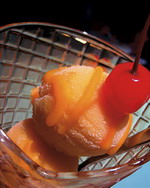
Advice to Consumers
- Buy frozen confections from reputable shops.
- Do not buy and consume any frozen confections which are beyond their expiry dates or not in a good quality.
- Store frozen confections in the appropriate compartments of the refrigerator after purchasing (chilled items (e.g. pudding): in the fridge at 4oC or below; frozen items (e.g. ice cream): in the freezer at -18oC or below).
- Observe the hygienic conditions of the retail shops including those of common area, equipment, utensils and whether food is handled in a hygienic manner. Also, check if the temperature in the storage facility is appropriate.
- Consume soft ice-cream immediately.
- Do not eat too much frozen confections and maintain a balanced diet.
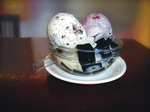
(II) Supplementary Information to Microbiological Guidelines for Ready-to-eat Food ("Supplementary Information")
As part of the Government's ongoing efforts to enhance food safety for the protection of public health and consumer interest, the Administration conducts regular review on microbiological food standards and guidelines and, where necessary, amends the standards / guidelines taking international standards and local situation into consideration. To facilitate monitoring and control of microbiological quality of bottled water, edible ice and non-bottled drinks, an Ad Hoc Working Group on Microbiological Safety of Food was formed in 2008 under the Expert Committee on Food Safety ("Expert Committee") to establish the microbiological criteria for bottled water and edible ice, and to review the microbiological criteria for non-bottled drinks. The Supplementary Information presents the criteria adopted by the Expert Committee. To familiarise the trade with the Supplementary Information, a trade seminar was organised on 24 April 2009 at the Lecture Hall of the Hong Kong Science Museum in Tsim Sha Tsui, and printed copies were distributed to the trade.
For a better understanding of the Supplementary Information, the public or the food trade can visit the website: http://www.cfs.gov.hk/english/food_leg/files/sup_inf-microbio_r-t-e_guidelines_e_final_V1a.pdf
while the website: http://www.cfs.gov.hk/english/faq/faq_11.html#sup_infoe
provides the frequently asked questions and answers relating to the Microbiological Guidelines for Ready-to-eat Food and the Supplementary Information.

(III) Human Swine Influenza and Food Safety
One day when Tommy came home after school ……
| Tommy : | Mom, I'm not going to school next week. Could you apply for leave of absence from school for me, please? |
|---|---|
| Mom : | There is an examination next week, isn't it? Why do you skip school? |
| Tommy : | Don't you know that there are confirmed cases of human swine influenza in Hong Kong ? I'm scared. I'd rather stay at home and not eating pork to prevent infection. |
| Mom : | Do you know what human swine flu exactly is? |
| Tommy : | ?????? |
| Mom : | Human swine influenza is caused by influenza A/H1N1 virus. Its transmission occurs in the same way as seasonal flu, mainly through coughing or sneezing of infected people. We may also become infected by touching our nose or mouth after touching objects soiled with the virus. |
| Tommy : | Will eating pork cause infection? |
| Mom : | No, it won't. Human swine flu is not transmitted by food. Eating properly handled and cooked pork and pork products is safe. As a general rule, pork should be cooked thoroughly before consumption with central part of the pork reaching at least 75°C. |
| Tommy : | But I'm concerned that you might get infected when you handle raw pork! |
| Mom : |
My dear Tommy. I'll not touch my face and other body parts when handling raw pork. Thereafter, I'll wash my hands thoroughly with warm soapy water and use hot water and detergent to cleanse all working surfaces, utensils and equipment that have been in contact with raw pork. There will be no room for slip-ups then. |
| Tommy : | We will also wash our hands with warm soapy water before and after meals. |
| Mom : | Well, your worries are now allayed. Go back to your room and prepare for your examination! |
| Tommy (murmuring) : |
Alas! I haven't read even a page of the book. The examination next week …… |
Advice to the Public
To ensure food safety, the public should follow the "5 Keys to Food Safety":
When buying and handling pork:
Choose
- Purchase pork from licensed fresh provision shops.
- Don't buy pork from questionable sources.
Clean
- Avoid touching raw pork directly when buying pork in the market.
- Observe good hygienic practices when handling raw pork. Upon touching raw pork, don't touch your face and other body parts. Thereafter, immediately wash hands thoroughly with warm soapy water. Thoroughly cleanse surfaces, utensils and equipment that have been in contact with raw pork with hot water and detergent.
Separate
- If raw pork is not used for immediate cooking, store it in a refrigerator. Raw food, including raw pork should be stored in containers with lids and put below cooked and ready-to-eat food.
Cook
- Pork should be cooked thoroughly before consumption with central part of the pork reaching at least 75°C.
Safe temperature
- Check the temperature of the refrigerator with a thermometer and ensure the fridge is kept at 4°C or below and the freezer at -18°C or below.
When eating out:
Choose
- Patronise reliable and hygienic shops.
Clean
- Wash hands thoroughly with warm soapy water before eating and after going to the toilet.
- Keep hands clean. Alcohol-based handrub is also effective when hands are not visibly soiled.
- Avoid touching mouth, nose and eyes.
- Cover nose and mouth when sneezing and coughing and do not spit.
Separate
- In some food premises like those providing buffets, check whether the raw food, including raw pork is separately placed from ready-to-eat or cooked dishes.
Cook
- If you suspect that the pork is not thoroughly cooked, ask the staff of the food premises to cook it again.
Safe temperature
- If you find that hot dishes, including pork dish are not served hot, ask the staff of the food premises to reheat the food.
Readers' Corner
(I) Microbiological Risks of Siu-mei and Lo-mei
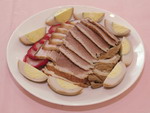
| Dad : | Son, the hawker ahead of us is selling BBQ pork and lo-mei. Let's buy some BBQ pork for your mom. |
|---|---|
| Fatty : | Dad, we have no idea if he is licensed or not, or if the BBQ pork he sells is hygienic or not! |
Siu-mei and lo-mei ( 燒味及鹵味 ), both traditional Chinese foods, are considered high-risk items in terms of microbiological risks. What should we do with them before we can consume them safely?
What are Siu-mei and Lo-mei?
Siu-mei is a group of meat products that has been roasted at a temperature of 200°C or above. Pork and poultry meat are often used for making siu-mei. Examples include roasted duck ( 燒鴨 ), roasted goose ( 燒鵝 ), roasted pork ( 燒肉、燒豬、燒排骨 ) and BBQ pork ( 叉 燒 ). Lo-mei is a foodstuff that has been soaked or immersed in large volumes of seasoning sauces prior to cooking. Some lo-mei items may be braised again after cooking and / or at the time of serving. Food groups that are commonly used to produce lo-mei include poultry meat ( 貴妃雞、豉油雞、鹵水鵝、鹵水雞肶及雞翼 ), red meat ( 鹵水牛肉 ) and offal products ( 鹵水雞腸、鵝腸及生腸 ).
Preparation of Siu-mei and Lo-mei
Roasting is the critical step to cook siu-mei products. At a temperature of 200°C or above, almost all microbiological hazards would be eliminated. The products are then cooled, delivered and displayed for sale. As for lo-mei, the main process involved is the use of marinade to impart the special taste and texture to the meat and offal. The meat and offal are first cooked with seasoning sauce or water, and then braised in the sauce for a period of time to enrich their flavour. The finished products can be served hot or cold.
Microbiological Risks of Siu-mei and Lo-mei
Some microorganisms, such as Campylobacter spp., Salmonella spp., Clostridium botulinum, Clostridium perfringens and Bacillus cereus, are the normal flora naturally present in raw meat and offal. Other microorganisms, such as Staphylococcus aureus, may be introduced during food preparation. In addition, the characteristics of the environment including relative humidity and temperature can influence the growth of microorganisms in siu-mei and lo-mei.
In terms of pathogenic contamination, Salmonella spp. and Staphylococcus aureus are the bacteria of concern. Salmonella spp. is commonly transmitted due to poor food and environmental hygiene, whereas Staphylococcus aureus is the normal flora found in hands and noses. Poor personal hygiene and post-heat treatment contamination are therefore the main reasons for the contamination of siu-mei and lo-mei by these bacteria. Moreover, storage of siu-mei and lo-mei for a prolonged period of time at ambient temperature is favourable for microbial growth. In view of these, we recommend the application of Hazard Analysis and Critical Control Point (HACCP) by the trade as the basis of the food safety plan to ensure food safety for siu-mei and lo-mei.
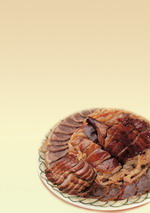
Advice to Consumers
- Purchase from hygienic and reliable shops.
- Observe whether food handlers maintain good personal hygiene. They should not be smoking, stroking their hair or have any open wounds.
- Observe whether the siu-mei and lo-mei are covered or displayed in insect-proof and dust-proof cabinets.
- Observe whether raw food is placed in the same cabinet for siu-mei and lo-mei.
- Consume siu-mei and lo-mei as soon as possible after purchase.
- Store the leftovers in a refrigerator and reheat them thoroughly before consumption.
(II) Pathogens Commonly Found in Bakery Products

Master A met dispirited Master B in the road one morning.
| Master A: | Why are you in such low spirit? Did you lose a lot on the stock market? |
|---|---|
| Master B: | I made some losses. But the worst part is that just as I am putting all my effort into the bakery after the financial tsunami, a Health Inspector came the other day and said that my cakes were suspected of causing food poisoning. You can't have harder luck than that! |
| Master A: | What can you do about what already happened? Let's look forward and think about some remedial measures. Today I am going to have tea with a veteran of our trade. Let's ask him for advice. |
Over tea
| Veteran : | Actually, bakery foods are very common. In recent years, many bakeries introduce new varieties of bakery products in addition to the traditional ones in a bid to give their products a greater public appeal. Bakery products like fresh cream cakes, swiss rolls and tiramisu are very popular. These goodies may involve a number of manual procedures during production, and with higher health risks too. |
|---|---|
| Master B: | In fact, food safety is already my greatest concern. How could there be a problem still? |
| Veteran : | Do you know that the pathogens commonly found in bakery products include Staphylococcus aureus, Salmonella spp. and Bacillus cereus? Staphylococcus aureus is generally found in foods contaminated by contact with the unclean hands, noses or wounds of food handlers or customers. Salmonella spp. often comes from the ingredients of bakery products, such as eggs and meat used for stuffing. Bacillus cereus may be present in flour. If these bacteria are not killed in the production process and survive in the bakery products, or the environment is unhygienic and the temperature is improper for the keeping of bakery products, cross-contamination and proliferation of bacteria may occur. As a result, health problems or even food poisoning may result from the consumption of these foods. |
| Master B: | You are a true master. If I had met you earlier, I would not have found myself with the present problem. It is a great lesson for me! |
Advice to Consumers
- Purchase from hygienic and reliable shops.
- Wash hands thoroughly with warm soapy water before eating.
- Store bakery products at proper temperatures. For example, tiramisu and birthday cakes should be stored at 4 o C or below.
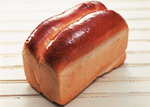
Food Safety Plan Corner
Critical Control Point of Preparing Steamed Minced Pork with Water Chestnut
Steaming, stir-frying, pan-frying and deep-frying are the most common cooking methods. Unlike the other three methods, steaming does not need additional oil, making it a low-fat and healthier way of cooking. A steamed dish, i.e. steamed minced pork with water chestnut, is chosen this time for providing you with some safe cooking tips. By ensuring food safety at all times, your family can enjoy the food safely.
Ingredients
| Fresh minced pork | 300 gram (about 8 taels) |
|---|---|
| Water chestnut | 6 pieces |
Seasoning
| Light soy sauce | 1 teaspoon |
|---|---|
| Sugar | 1/2 teaspoon |
| Corn flour | 1 teaspoon |
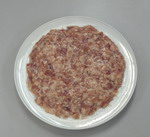
Steps
- Peel, rinse and dice water chestnuts.
- Add water chestnuts and seasoning into the minced pork, mixing well. Marinate for 15 minutes.
- Steam for 15 minutes on high heat.
Production Process
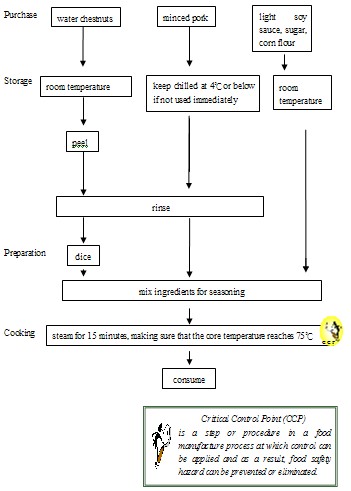
Safety Tips on Production of Steamed Minced Pork with Water Chestnut
- Purchase
- Purchase the ingredients from reliable and hygienic shops.
- When buying the ingredients, make sure that:
- the ingredients are fresh and wholesome.
- the fresh minced pork is purchased from a licensed fresh provision shop.
- the water chestnuts are neither damaged nor bruised on the surface.
- prepackaged food items (e.g. sugar, corn flour) are used before the expiry date.
- Storage
- Store the ingredients immediately at safe temperature as soon as possible.
- Minced pork not for immediate use should be stored in a refrigerator. The temperature inside the refrigerator should be checked regularly with a thermometer to ensure that the fridge remains at 4oC or below.
- Raw minced pork should be stored in a container with a lid and put under cooked food or ready-to-eat food to avoid cross-contamination.
- Practise the first-in-first-out principle for storage.
- Store the ingredients immediately at safe temperature as soon as possible.
- Preparation
- Before cooking, wash all food contact surfaces (including worktops, chopping boards and utensils) thoroughly.
- Before cooking / in the course of preparing food, wash hands thoroughly with warm soapy water.
- Use two different sets of utensils (including knives, chopping boards, bowls and chopsticks) to handle raw and cooked food separately.
- Before cooking, rinse the minced pork and water chestnuts.
- Marinated pork not for cooking immediately should be stored in a refrigerator at 4oC or below.
- Cooking
- The food should be thoroughly cooked before consumption until the meat juice becomes clear and not red.
- Use a clean food thermometer to measure the core temperature of the food, which should reach at least 75 ℃ . (CCP)
- Consumption
- The cooked food should be consumed as soon as possible. It should not be kept at room temperature for more than 2 hours.
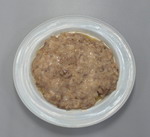
Food News
Turn and Look - For Healthier Food Choices
Nutrition Labelling Series – Measuring Units for Nutrients
In the last issue, we introduced energy and its measuring units. In this issue, we would like to provide you with answers to some of the questions concerning units for nutrients.
Question 1: Are measuring units for nutrient contents the same as units for weight?
Generally speaking, measuring units for nutrient contents are units for weight. For measuring nutrient contents, metric units (e.g. gram, milligram or microgram) are used in the international community. Therefore, we usually say 60 grams of protein and 1 000 milligrams of calcium, instead of 2 ounces of protein and 0.003 ounce of calcium.
Question 2: Why is the measuring unit for Vitamin A (μg Retinol Equivalents) different from the units for other nutrients?
More than one type of similar bioactive compounds (e.g. β-carotene, α - carotene) can be converted into Vitamin A (its scientific name is known as "Retinol") in the human body. And the conversion rate and absorption rate of various bioactive compounds are different (e.g. 6 μg of β-carotene is only equal to 1 μg of Vitamin A). Therefore, the content of these bioactive compounds cannot be directly applied in calculating the total content of Vitamin A.
To accurately calculate the total content of Vitamin A in food, all bioactive compounds must first be converted to Vitamin A (or Retinol Equivalents), and then added up as the total. The unit for calculating Vitamin A is therefore known as μg Retinol Equivalents (μgRE), which refers to the total content of Vitamin A and the bioactive compounds. A similar concept also applies to the calculation of Vitamin E (unit for calculation: α-Tocopherol Equivalents (mg α-TE)) and folic acid (unit for calculation: μg Dietary Folate Equivalents (μg DFE)).
Question 3: Why is Vitamin A expressed in international units (IU) on some nutrition labels?
International Units (IU), commonly used in the past (1 μgRE= 3.33 IU), are less often used nowadays. Under the regulation on nutrition labeling, to come into force in July 2010, all nutrients should be expressed in metric units (i.e. gram, milligram or microgram).
Briefing of Activities
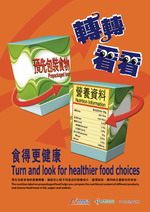
(I) Publicity and Education Campaign on "Nutrition Labelling"
The Food and Drugs (Composition and Labelling) (Amendment: Requirements for Nutrition Labelling and Nutrition Claim) Regulation 2008 (Amendment Regulation) was passed by the Legislative Council on 28 May 2008 and will come into effect on 1 July 2010 . Upon the implementation of the labelling scheme, consumers can view energy content and values of seven specified nutrients, namely protein, total fat, saturated fat, trans fat, carbohydrates, sugars and sodium (i.e. 1+7), on the nutrition labels of most pre-packaged food products sold in the local market. Nutrition claims on food labels or promotional materials will also be regulated. Food products must comply with certain conditions when making nutrition claims. For instance, when a "low sugars" nutrition claim is made, consumers will know that the sugars level of the food is not more than 5 g per 100 g/ml.
To assist the public to understand the new Regulation and to help consumers make good use of the information on nutrition labels, the Centre for Food Safety (CFS) has been actively engaged in the publicity and education on this front to facilitate a smooth implementation of the nutrition labelling scheme next year. The three-year Publicity and Education Campaign was officially launched in March this year and a number of publicity and teaching materials have been prepared. The newly produced TV and radio announcements of public interest "Turn and look for healthier food choices" have been broadcasting since this March to encourage people to study nutrition labels and choose food lower in fat, sugars and sodium. A thematic video, posters, booklets and souvenirs on nutrition labelling have been produced to further enhance public knowledge on the scheme. In addition, the CFS organised roving exhibitions in shopping malls in different districts including Tuen Mun, Tai Po, Fanling, Wong Tai Sin, Kwun Tong, etc. between April and May to educate the public on nutrition labelling. The roving exhibitions will continue to be held in the shopping malls of other districts.
Members of the public can get information on nutrition labelling from the CFS web page (www.cfs.gov.hk). They can also obtain or borrow publicity materials on nutrition labelling from the Communication Resource Unit, CFS at 8/F, Fa Yuen Street Municipal Services Building, 123A Fa Yuen Street , Mong Kok, Kowloon .

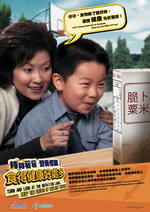
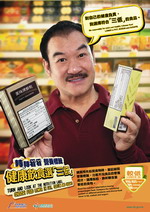

(II) Food Safety Day 2009
The Centre for Food Safety organises Food Safety Day every summer to promote public awareness of food safety. Food Safety Day 2009, which will focus on promoting nutrition labelling, will be held at Tai Po Mega Mall on 11 July 2009 . Games, performances by singers, displaying exhibition panels and distributing leaflets are some of the on-site activities. Souvenirs will be handed out to participants in game booths. The public are welcome to join the event. Relevant details will be announced in the CFS web page (www.cfs.gov.hk) later.
Brief Notes on the Legislation Amendment to the Chinese Rendition of "Use by" Date on Labels of Prepackaged Foods
The proposed amendment to the Chinese rendition of "use by" date on labels of prepackaged foods was passed by the Legislative Council on 30 April 2008 and published in the Gazette on 9 May 2008. The amendment intends to better reflect the legislative intent and to tie in with the Chinese translation of "use by" date (" 此日期或之前食用 ") in Schedule 6 to the Food Business Regulations, Cap. 132X on the labelling of chilled beef, mutton or pork. The amendment aims to replace the Chinese rendition of "use by" date (" 此日期前食用 ") in the provisions of the Food and Drugs (Composition and Labelling) Regulations, Cap. 132W by " 此日期或之前食用 " . The amendment will take effect on 1 July 2010 . The relevant notice was published in the Gazette in May 2009. The trade may change the labels during the transition period before 30 June 2010 . Members of the public should note that only the Chinese rendition will be amended while the English wordings remain unchanged. Moreover, no amendments have been made to the wordings of "best before" date (" 此日期前最佳 "). For details of the amendment, please visit the CFS web page (http://www.cfs.gov.hk) for the relevant information.